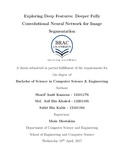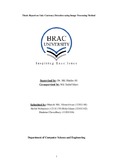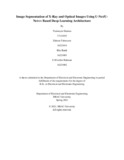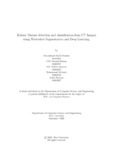Browsing by Subject "Image segmentation"
Now showing items 1-6 of 6
-
Exploring deep features: deeper fully convolutional neural network for image segmentation
(BRAC University, 4/19/2017)Classification of images has been a widely regarded challenge for the past decade, but a new type of object recognition problem which deals with pixellevel segmentation is posing a more complex task for both computer vision ... -
Fake currency detection using image processing method
(BRAC University, 2016)Fake notes area problem of almost every country. For country like Bangladesh it is becoming big hurdle. Fake Bangladeshi Currency of 1000 seems to have flooded the system and there is no proper way to deal with them for ... -
Image segmentation of X-Ray and optical images using U-Net/UNet++ based deep learning architecture
(Brac University, 2021)Image segmentation is a fundamental section of the current healthcare system to segment and detect diseases such as disease of the lung (pneumothorax), cancer, diabetic retinopathy, dengue, malaria, heart disease, ... -
Integration of handcrafted and deep neural features for Melanoma classification
(Brac University, 2021-09)Deep neural networks (DNNs) are widely utilized to automate medical image in- terpretation in many forms of cancer diagnosis and to support medical specialists with fast data processing. Although man-made characteristics ... -
Kidney Disease detection and classification from CT Images using Watershed Segmentation and Deep Learning.
(Brac University, 2022-09)Chronic kidney disease, often called chronic kidney failure, is a steady decline of renal function. Some of the most common reasons for kidney failure are cyst, stone and tumor. There may be no symptoms of chronic renal ... -
Transfer learning based industrial steel plates fault diagnosis using industrial fault signals
(Brac University, 2021-09)Transfer learning (TL) has shown its great advantage to solve small-training-sample issues utilizing information learned from existing large data with deep learning tech- niques. Transfer learning has been e ectively ...






